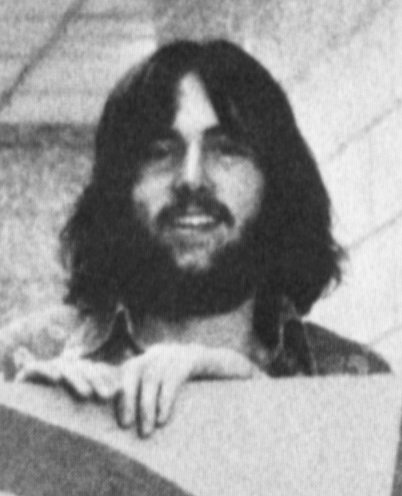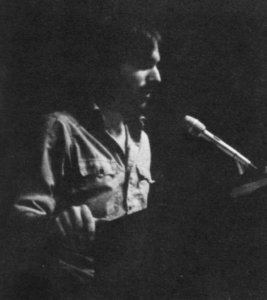
High school, 1976.
Photo by Walt Hines.
2. EMERGING IN
HIGH SCHOOL
(1973-77)
 High school, 1976. Photo by Walt Hines. |
As is probably true with most people, I really began to discover who I was in high school. At this point, I began to come out from under my parentsí wings. I was a pretty responsible kid, and my parents let me pretty much come and go as I pleased, compared to other kids' families. Getting around on my blue ten speed bicycle allowed me to choose my friends and hang out with them. I began to notice a bit more how I dressed and began to get choosier when Mom took me clothes shopping. But she never bought me that leather jacket I always asked for. She said I'd look like a "hood." Wouldn't you know, first paycheck from my first job after college, I bought a black leather motorcycle jacket. That came in handy during my upcoming band days! I got part-time jobs as a newspaper boy and janitor, and that gave me more discretionary income to spend on books and music.
The biggest changes in my life at this point occurred in the field of music. During my Freshman year, in English class, we had a regular show and tell day. Once, a girl named Janice Anders brought in a 45-rpm single of The Doobie Brothersí song "China Grove." She said she enjoyed collecting music and played us her latest acquisition. Up until then, my experience with music was listening to my Dadís big band recordings with some oldies played on the radio. I was exposed to music, but I never really thought about it. When I heard the electric guitars and the rock rhythm of "China Grove," I felt something calling to me. I still have the image of that moment, when the needle dropped into the groove, burned into my memory. It didnít take me long to find out there were whole entire stores specializing in this rock and roll stuff. They even play it for free over certain radio stations! My soundtrack album to 2001 (which had its own impact on my musical sensibilities) was quickly shoved to the back behind Chicago, Led Zeppelin, Rolling Stones, Beatles, Pink Floyd, and Emerson, Lake & Palmer albums.
 Senior year, 1976. Photo courtesy Snider yearbook. |
As I was with visual art, I was inspired to mimic my musical heroes. My favorite band was Chicago, known for their trademarked horn section. I thought the trumpet looked like a really cool instrument, so I told Mom I wanted to take trumpet lessons. Since most kids donít want to take music lessons, I figured she would jump on the chance to sign me up, but for some reason, time passed and nothing happened.
One day, I was watching TV when I saw an interview with Eric Clapton. One of the questions asked was , "You play guitar, Eric, but it sounds like a different instrument on each song. How do you do that?" Clapton strummed the guitar in his lap, and it sounded like a typical electric guitar with metal strings. He then used his foot to switch on a box at his feet, and when he strummed the instrument again, it emitted a distorted crunch perfect for rock like Led Zeppelin's. Then he activated another box and the sound was all echoey and spacey like something Pink Floyd would do. Suddenly, the trumpet was not looking so hot! Here was the instrument that crafted rock music, and thatís what I wanted, along with some of those cool boxes!
The day after the Clapton interview, I told Mom I wanted to play electric guitar, and within a week I was signed up for lessons and actually owned a guitar and small amplifier. I still have the guitar to this day. I was using this equipment when I began early experiments taping myself playing and trying to write music. I found out later on that the reason Mom hesitated about signing me up for trumpet lessons was that she didnít want to have to listen to me practice loudly, and with a trumpet, loud is a given for the most part. Thank goodness for Eric Clapton!
 In the Art Club, 1977. Photo courtesy Snider yearbook. |
As most child artists do, I had gauged my artistic success by how much what I drew looked like a photograph of the object. This was my way of internalizing the outside world. I realized that part of what makes an artist special is his ability to pull things from within himself and make them real through art, externalizing his imagination. Much as the writers and filmmakers I admired told stories culled from their imaginations, so I realized I could find things within myself to express what no one else had yet presented to the world. Suddenly, I was no longer a copy machine, but a creator, and this is how I've thought of myself ever since. My lifetime search for original expression had begun. I hope this originality is what will eventually separate me from all the other artists out there.
 Voted Most Artistic Award. Photo courtesy Snider yearbook. |
I was also greatly impressed by cartoon art. Not the detailed cartoons of the comic books, but the simplified graphics of newspaper cartoons. It amazed me the way they could suggest entire worlds with only a minimum of linework. Not only did I read the newspaper comics each day, but I studied them. I found myself imitating the simplified styles of Johnny Hart (B.C.) and Charles Schultz (Peanuts). A friend of mine at school, Chris Hoot, had a father who was a talented cartoonist. I learned much about cartooning from watching Chris draw, imitating his father's style. From this I learned that an artist does not have to render everything in photographic detail. The human mind was capable of filling in a lot with only sketchy guidance. This observation was subsequently reinforced when I studied Picasso's own cartoonish line drawings.
This time period probably represented the height of my reading fixation. I don't have much time to read any more, but then I was devouring books. Eventually, I came to the inevitable conclusion that I was also capable of writing a good story. Coinciding with this reading high, I also wrote a great deal. I concentrated on short stories, and I often wrote adventure stories featuring my friends. When one of these friends would have a birthday, I would write them a fifteen page-or-so story, and one of the kids who was good at doing impressions would read it aloud to the birthday gathering, playing each of the parts as he went. I also wrote a science fiction romance novel for a girl I was crazy about, featuring characters which stood in for the girl and myself. Many of these stories are very juvenile, as I go back and read them now, so they will probably not be posted, but I think I might someday rework the science fiction novel into something interesting. Now, most of my writing talents go into song lyrics, which I like to think of as a form of poetry (thank you, Bob Dylan), not just throw away song words.
I spent most of my free time in high school doing the usual things: dating, going to movies, hanging out with friends, learning to drive, listening to records, and so on. But I also spent vast amounts of time writing, painting, drawing, and playing guitar. Is it any wonder I decided to go to art school after graduation in 1977?
Go to Next Chapter
Return to Last Chapter
© 2000 by Rick Hines.
Material may not be used
without the artist's written permission.